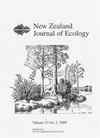The pattern of declines and local extinctions of endemic inland Lepidium species in the eastern South Island
IF 1.4
3区 环境科学与生态学
Q3 ECOLOGY
引用次数: 0
Abstract
: Small patches of habitat for indigenous species that remain in developed landscapes are predicted to lose species over time as extinction debts are paid off and to become transformed by spillover from intensive land uses. In December 2020 we searched for plants of three inland South Island-endemic species of Lepidium (Brassicaceae; L. kirkii , L. sisymbrioides , and L. solandri ) at previously known locations in Central Otago, the Waitaki Valley, the Mackenzie Basin, and Kura Tāwhiti (Castle Hill, North Canterbury). We recorded whether Lepidium populations remained and identified the vascular plant flora of each location. Lepidium kirkii was found at six of 14 locations where formerly known and at one new location, but numbered over 50 individuals at only one of these locations. Lepidium sisymbrioides was found at five of six locations visited, but we found fewer than four individuals at three of these locations. L. solandri was found at five of 12 formerly known locations in Central Otago (but numbered over 50 individuals at only one), at five of five formerly known locations on public land in the Mackenzie Basin, and at the one known location at Kura Tāwhiti. Exotic vascular plant species outnumbered native species at all but one Lepidium location in Central Otago and at Kura Tāwhiti, but not in the Mackenzie Basin, where there had been the least habitat loss and land-use intensification. Our results are consistent with theoretical predictions of more local plant extinctions at Lepidium locations, and greater transformation of their habitats, in landscapes dominated by intensive land uses and non-indigenous vegetation. We conclude that intensive ex situ and in situ management is now needed to avoid global extinctions of L. kirkii and L. sisymbrioides , and local extinctions of L. solandri at remaining Central Otago locations and at Kura Tāwhiti. We do not know whether landscape-scale processes still provide for the persistence of L. solandri and other dryland species in the Mackenzie Basin or whether intensive land use has already crossed ecological thresholds.南岛东部内陆特有蚤属物种的减少和局部灭绝模式
本文章由计算机程序翻译,如有差异,请以英文原文为准。
求助全文
约1分钟内获得全文
求助全文
来源期刊

New Zealand Journal of Ecology
环境科学-生态学
CiteScore
3.00
自引率
12.50%
发文量
35
审稿时长
>36 weeks
期刊介绍:
The New Zealand Journal of Ecology is a biannual peer-reviewed journal publishing ecological research relevant to New Zealand/Aotearoa and the South Pacific. It has been published since 1952 (as a 1952 issue of New Zealand Science Review and as the Proceedings of the New Zealand Ecological Society until 1977). The Journal is published by the New Zealand Ecological Society (Inc.), and is covered by Current Contents/Agriculture, Biology and Environmental Science, GEOBASE, and Geo Abstracts.
 求助内容:
求助内容: 应助结果提醒方式:
应助结果提醒方式:


